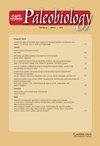Frond orientations with independent current indicators demonstrate the reclining rheotropic mode of life of several Ediacaran rangeomorph taxa
IF 2.6
2区 地球科学
Q2 BIODIVERSITY CONSERVATION
引用次数: 3
Abstract
Abstract.— Fossils from the deep-sea Ediacaran biotas of Newfoundland are among the oldest architecturally complex soft-bodied macroorganisms on Earth. Most organisms in the Mistaken Point–type biotas of Avalonia—particularly the fractal-branching frondose Rangeomorpha— have been traditionally interpreted as living erect within the water column during life. However, due to the scarcity of documented physical sedimentological proxies associated with fossiliferous beds, Ediacaran paleocurrents have been inferred in some instances from the preferential orientation of fronds. This calls into question the relationship between frond orientation and paleocurrents. In this study, we present an integrated approach from a newly described fossiliferous surface (the “Melrose Surface” in the Fermeuse Formation at Melrose, on the southern portion of the Catalina Dome in the Discovery UNESCO Global Geopark) combining: (1) physical sedimentological evidence for paleocurrent direction in the form of climbing ripple cross-lamination and (2) a series of statistical analyses based on modified polythetic and monothetic clustering techniques reflecting the circular nature of the recorded orientation of Fractofusus misrai specimens. This study demonstrates the reclining rheotropic mode of life of the Ediacaran rangeomorph taxon Fractofusus misrai and presents preliminary inferences suggesting a similar mode of life for Bradgatia sp. and Pectinifrons abyssalis based on qualitative evidence. These results advocate for the consideration of an alternative conceptual hypothesis for position of life of Ediacaran organisms in which they are interpreted as having lived reclined on the seafloor, in the position that they are preserved.具有独立电流指示的前缘取向显示了几个埃迪卡拉纪范围形态分类群的斜倚流变生活方式
摘要来自纽芬兰深海埃迪卡拉生物群的化石是地球上最古老的建筑复杂的软体大型生物之一。在avalonia的错误点型生物群中,大多数生物,特别是分形分支的frondose Rangeomorpha,在传统上被解释为在生命中直立生活在水柱中。然而,由于缺乏与化石层相关的物理沉积学指标,在某些情况下,埃迪卡拉纪的古流是通过叶的优先取向来推断的。这使人们对锋面取向和古海流之间的关系产生了疑问。在这项研究中,我们从一个新描述的化石表面(梅尔罗斯Fermeuse组的“梅尔罗斯表面”,位于发现联合国教科文组织世界地质公园卡塔利娜圆顶的南部)提出了一种综合方法,结合:(1)以爬升纹波交叉层压形式提供的古水流方向的物理沉积学证据;(2)基于改进的聚类和单聚类技术的一系列统计分析,反映了Fractofusus misrai标本所记录的方位的圆形性质。本研究证明了埃迪卡拉纪范围形态分类群Fractofusus misrai的斜卧流变性生活方式,并根据定性证据提出了Bradgatia sp.和Pectinifrons abyssalis类似生活方式的初步推论。这些结果提倡考虑另一种关于埃迪卡拉纪生物生命位置的概念假设,在这种假设中,它们被解释为斜倚在海底生活,在它们被保存的位置。
本文章由计算机程序翻译,如有差异,请以英文原文为准。
求助全文
约1分钟内获得全文
求助全文
来源期刊

Paleobiology
地学-古生物学
CiteScore
5.30
自引率
3.70%
发文量
38
审稿时长
>12 weeks
期刊介绍:
Paleobiology publishes original contributions of any length (but normally 10-50 manuscript pages) dealing with any aspect of biological paleontology. Emphasis is placed on biological or paleobiological processes and patterns, including macroevolution, extinction, diversification, speciation, functional morphology, bio-geography, phylogeny, paleoecology, molecular paleontology, taphonomy, natural selection and patterns of variation, abundance, and distribution in space and time, among others. Taxonomic papers are welcome if they have significant and broad applications. Papers concerning research on recent organisms and systems are appropriate if they are of particular interest to paleontologists. Papers should typically interest readers from more than one specialty. Proposals for symposium volumes should be discussed in advance with the editors.
 求助内容:
求助内容: 应助结果提醒方式:
应助结果提醒方式:


